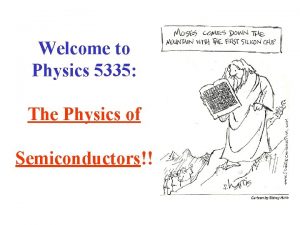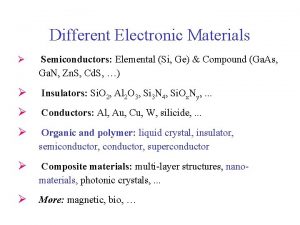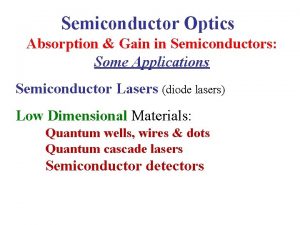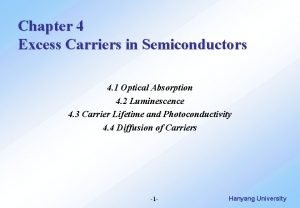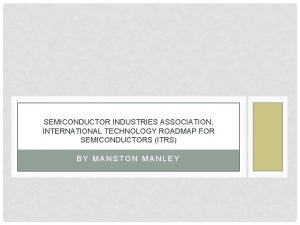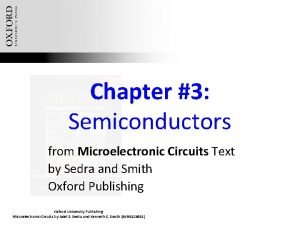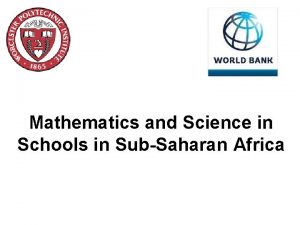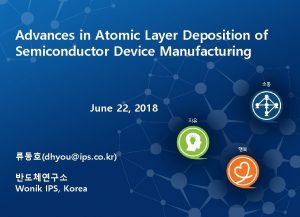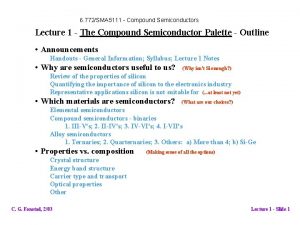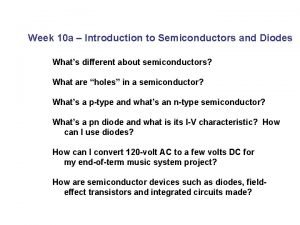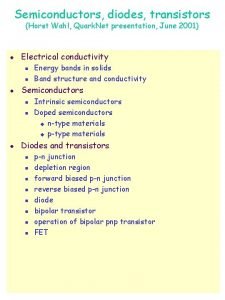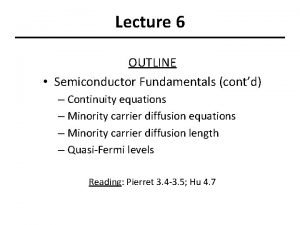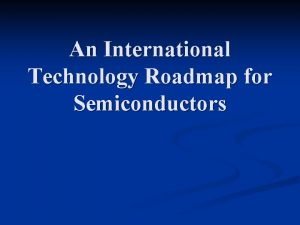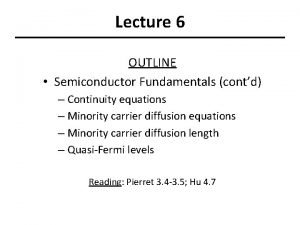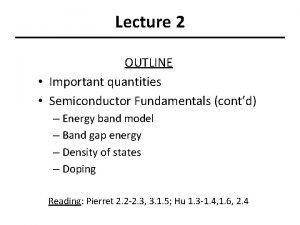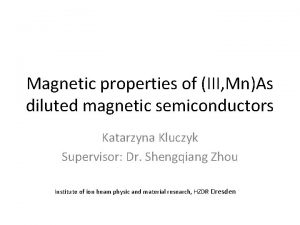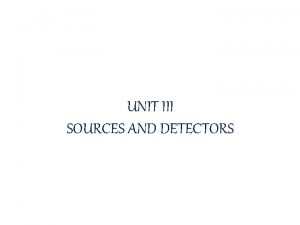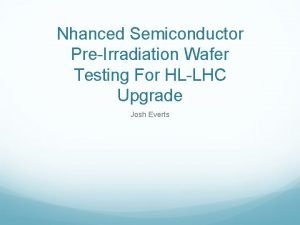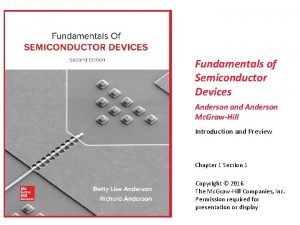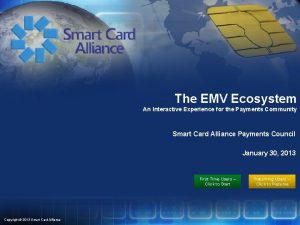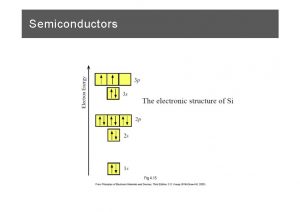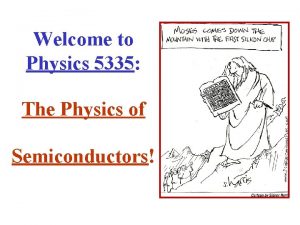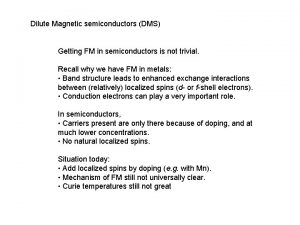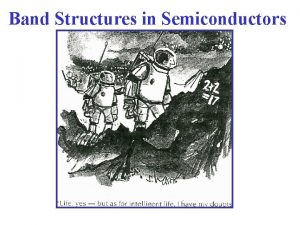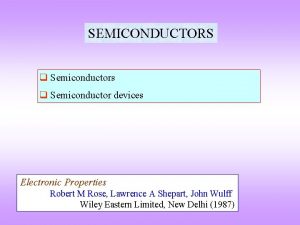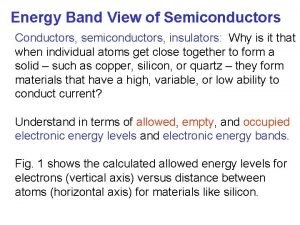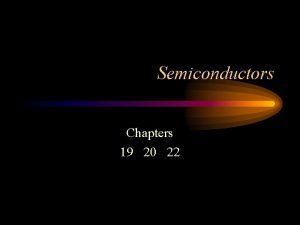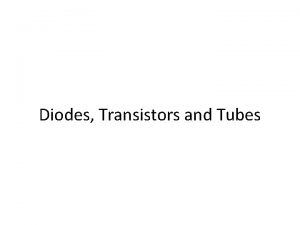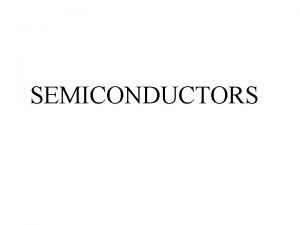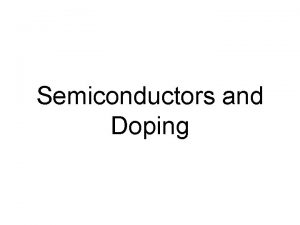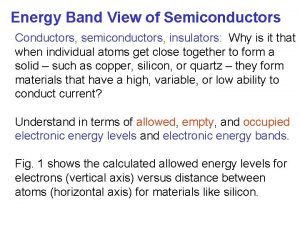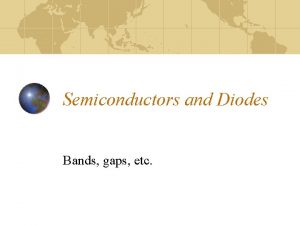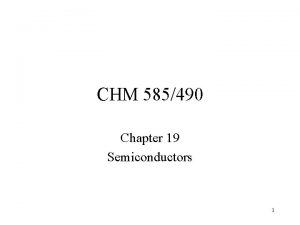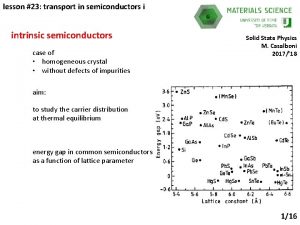Welcome to Physics 5335 The Physics of Semiconductors




















- Slides: 20

Welcome to Physics 5335: The Physics of Semiconductors!!

Class Web Page! http: //www. phys. ttu. edu/~cmyles/Phys 5335/5335. html Parts of this page are UNDER CONSTRUCTION! There you will find: 1. Posted (Word format): Syllabus, Help Resources, Semiconductor Resources, Exams & Homework (eventually with solutions). 2. Posted (Power Point format): Lectures 3. Important Class Announcements & Calendar Items! 4. Links to Web Pages for semiconductor physics 5. Other important items relating to this class. PLEASE!! Get into the habit of checking this page often!

Announcement Page! My Web Page • Linked from the class Web Page is: The Announcement Page: http: //www. phys. ttu. edu/~cmyles/Phys 5335/announce. html – Contains class announcements & major calendar items. Please check it often! • You might also check out My Web page at: http: //www. phys. ttu. edu/~cmyles/

Physics 5335 • Email Distribution List! – It is VERY important that you have an email address & that I have it!!! – I will use the email distribution list to make important class announcements!!! – It is VERY important that you check your email DAILY!!! (PLEASE tell me if you change email address!)

Assignment Number 1 For 20 extra points towards your homework grade!! • Send me an email message: – Be sure to include your name & Physics 5335 in the message. – Email address: Charley. Myles@ttu. edu Due 5 PM Friday, August 31, 2012!!!

Homework = 40% of Grade Homework will be assigned regularly!! • It may come from our text or elsewhere. • Working problems is the most effective means of learning physics. Homework is due at 5 PM on the due date. NO late homework will be accepted You are strongly encouraged to work on homework, in groups together! This is how most scientists & engineers work in the “real” world!

Mid Term Exam = 30% of Grade It Will be a Take Home Exam: BUT – It will have mostly qualitative questions that must be answered using words, not math. The idea of this is to assess your understanding of physical concepts. – Your understanding of the needed math skills will be assessed with the Homework.

Semester Project = 30% of Grade (instead of a Final Exam!) Oral Presentation + Written Paper • Library Research on an advanced topic or application of semiconductor physics we don’t have time for in class. Choose the topic by Mid-Semester (Monday, Oct. 22) Have the topic approved by me before starting. Oral Presentations Will be scheduled during final exam period (Dec. 10 - 15) Written Paper Will also be due at that time.

Where to Go for Help? ? Your Fellow Students!!! • A very effective strategy is to work on homework and to study together in a group. • This is how professionals work in the “real world”. Me (office hours or not!) The Internet!!! • There are LARGE numbers of Semiconductor Physics websites! Using Google. com & typing in “Semiconductor Physics” gives millions of hits!!!! Class Web Page!

To Succeed in this Course • READ the book, which cost you many $$$! It’s most effective to read the material BEFORE I lecture on it. • READ some of the supplementary books or other resources to give you different treatments of the material. • WORK the assigned homework problems!! – It is IMPOSSIBLE to learn physics without working problems!!! – Copying other people’s solutions or solutions from the web will NOT teach you physics!

To Succeed in this Course COME TO CLASS!! • There is a correlation between attendance & grade! Also, skipping means that you are WASTING the tuition & fees that you (or someone) paid! With tuition & fees for a full-time student, each class meeting costs about $25. Each time you skip, you are throwing away $25!! After a while this adds up! My lectures may not be entertaining or brilliant, but I do expose you to the material. ATTENDANCE!!! THE WEEKEND DOESN’T BEGIN THURSDAY, which is a regular CLASS DAY!!!!

Books Primary Textbook Semiconductor Physics & Applications by M. Balkansi & R. F. Wallis. – Portions of lectures will be from it, but also from the 2 supplements. Topics will be discussed in approximately the same order as the table of contents. – Material from many other sources will also be used. – It's available at bookstores (? ), on-line, in hardbound or paperback. I urge you to shop around & find the best price. Supplemental Textbooks Optional. Some portions of the course will use some information in them. 1. Fundamentals of Semiconductors, by P. Y. Yu & M. Cardona. 2. Semiconductor Physics, by K. Seeger.

Course Objective To expose students to the rich, broad, varied field of SEMICONDUCTOR PHYSICS. • This ISN'T a semiconductor device course, but a course on the microscopic material properties of semiconductor materials!! • A semiconductor device course is Physics 5336, Device Physics. • This course is designed to complement & supplement Physics 5304, Solid State Physics (offered Fall in odd numbered years). Obviously, there is large overlap between Solid State & Semiconductors, but one course should NOT be considered a replacement for the other!! • We'll discuss the microscopic physics of mostly, CRYSTALLINE semiconductors. • It would help if you already knew some basic solid state physics, but it isn’t vital!

What is Semiconductor Physics? • “Semiconductor Physics” can be defined as study of the materials that are important for modern technology. As we'll see, the physics of semiconductor materials is really much more than that! It is a very important branch of the broader discipline of “Solid State Physics”, which is study of the microscopic properties of the dense assembly of electrons formed by placing atoms very close together in a solid. Solid State is very large, very broad physics sub-field. • In some sense, Solid State Physics is “the opposite” of Particle Physics. • Particle Physics focuses on properties of INDIVIDUAL particles. – Particle physicists break objects up into their constituent building blocks. • Solid State Physics deals with the microscopic properties of Large COLLECTIONS of particles. – Solid State physicists are interested in what fundamentally NEW PROPERTIES emerge when these building blocks are grouped together in various ways.

Motivations for the Study of Semiconductor Physics • Technological & Basic Physics motivations to study Semiconductor Physics. Technological Motivations • A very important motivation is that the microscopic properties Semiconductor Physics deals with are responsible for the majority of modern technology. – These properties determine the mechanical strength of materials, how they interact with light, how they conduct electricity, etc. – So, Semiconductor Physics is important for technology, because it gives guidance on the design the circuits needed for modern electronic devices. This field gave us the transistor & the semiconductor chip! – So, Semiconductor Physics is traditionally linked to materials science, chemistry & engineering. – Recently, it has developed overlaps with biology, biochemistry, biotechnology & medicine. – So, many current research questions in Semiconductor Physics are still at the frontiers of applied science & next-generation technologies.

Basic Physics Motivations • A very important motivation to study Semiconductor Physics is that the fundamental physics needed to understand the microscopic properties of these materials is very interesting. – To understand these properties, the ideas & methods of quantum mechanics must be used. The physics of solids is VERY deeply quantum mechanical. – So, Semiconductor Physics has sometimes been called the best “lab” for studying subtle quantum mechanical effects. – This course may be a first chance for students to see quantum mechanical ideas & methods applied to cases where their technological consequences are so important.

• Just 2 examples (of MANY!) in which Semiconductor Physics discoveries have revealed very interesting, fundamental physics are observations/explanations of 1. The Quantum Hall Effect 2. The Fractional Quantum Hall Effect • Both have exotic quantum mechanical explanations. • A strong indicator that Semiconductor Physics has led (& continues to lead!) to the understanding of many very interesting basic physics phenomena is the fact that: More than 40% of Physics Nobel Prizes in the past 40 years & 50% of those in the past 12 years have been for work in Semiconductor Physics

The Semiconductor Physics Research Area • Many of you are likely taking this course because it is related to your research area. You've chosen a very good, interesting field! LARGE quantities of new physics is discovered in this area (& in its “parent field” of Solid State) all of the time. • For example, the American Physical Society's (APS) Division of Condensed Matter Physics or DCMP ("Condensed Matter" is ~ the same as “Solid State”) is, BY FAR, the largest APS division! ~(1/3) of the ~ 50, 000 APS members belong to DCMP. • Another APS division is the Division of Materials Physics or DMP (“Materials Physics” is ~ the same as “Applied Solid State”), started 12 -15 years ago. The DMP is rapidly growing & may eventually become similar in size to the DCMP. (Many people belong to both!). • BY FAR, the largest annual APS meeting is the joint DCMP & DMP meeting. It is held each March (it's called the “March Meeting” !). • 2012 March Meeting (Boston, MA): ~7, 000+ people & ~5, 000+ papers!

The American Physical Society (APS) No matter what their research area Every Physics Graduate Student, + every undergrad who wants to go to graduate school should join the APS!! The first year's membership is FREE to students & the following student years are highly discounted!

The Materials Research Society (MRS) Graduate students working in Solid State, Condensed Matter, or Materials Physics should also consider joining the MRS!! • The MRS is another large professional organization, but it has a very interdisciplinary membership. This reflects the fact that people with many different backgrounds are doing various kinds of materials research. For example, it has members with backgrounds in Physics, in Chemistry, & in various types of Engineering.
 The physics of semiconductors
The physics of semiconductors Elemental and compound semiconductors
Elemental and compound semiconductors Semiconductor
Semiconductor Excess carriers in semiconductors
Excess carriers in semiconductors International roadmap for semiconductors
International roadmap for semiconductors Semiconductors
Semiconductors Semiconductor examples
Semiconductor examples Semiconductor
Semiconductor Elemental and compound semiconductors
Elemental and compound semiconductors Introduction to semiconductors
Introduction to semiconductors Semiconductors
Semiconductors Continuity equation of semiconductor
Continuity equation of semiconductor International technology roadmap
International technology roadmap Continuity equation semiconductor
Continuity equation semiconductor Semiconductors band gap
Semiconductors band gap Konduktor isolator semikonduktor
Konduktor isolator semikonduktor σsk
σsk Direct and indirect band gap semiconductors
Direct and indirect band gap semiconductors Nhanced semiconductors
Nhanced semiconductors Fundamentals of semiconductor devices anderson 솔루션
Fundamentals of semiconductor devices anderson 솔루션 Bank of america semiconductors
Bank of america semiconductors
